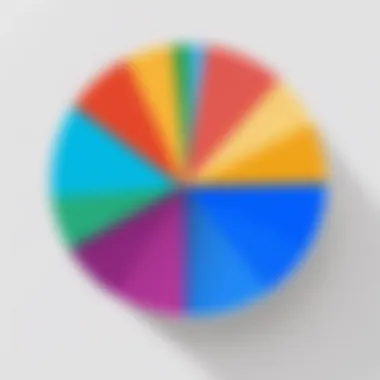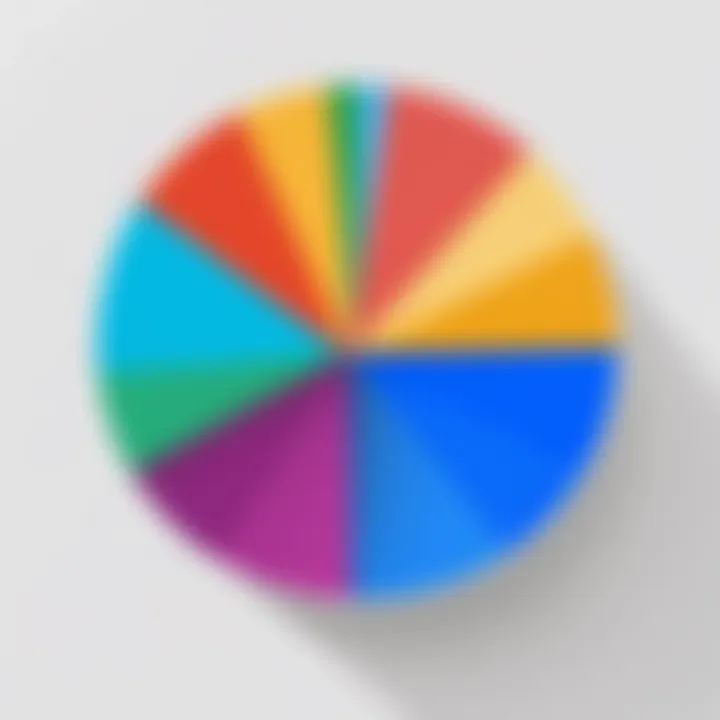Creating Graphs in Google Docs: A Comprehensive Guide


App Overview
Prolusion to Google Docs and Its Main Features
Google Docs is a cloud-based word processing application that is part of the Google Workspace suite. It allows users to create, edit, and collaborate on documents online. This app is favored for its simplicity and powerful collaboration features. Users can work on documents simultaneously, access them from anywhere, and share easily with colleagues or friends. In addition to text editing, Google Docs offers a variety of tools, including the ability to insert graphs and charts directly into your documents.
Key Functionalities and Benefits of Using Google Docs
When it comes to data visualization, Google Docs provides seamless integration with Google Sheets for creating graphs. This feature shines for professionals who often need to present data clearly and succinctly. Here are some of the main benefits of using Google Docs for graph creation:
- Accessibility: As a cloud-based tool, you can access your documents from any device with internet connection.
- Real-time collaboration: Multiple users can edit a document together, making it easy for teams to work on presentations or reports.
- Easy to use: The user-friendly interface allows even beginners to create graphs without steep learning curves.
- Embedded graphs: Once a graph is created in Google Sheets, it can easily be inserted into your Google Docs, maintaining live links for automatic updates.
Step-by-Step Walkthrough
Creating graphs in Google Docs isn’t as arduous as it might appear. Follow this structured approach to create your first graph, step by step.
- Open Google Sheets: Start by launching Google Sheets to input your data.
- Insert a Graph: Navigate to the top menu and click on > .
- Customize Your Chart: After insertion, a Chart Editor will appear, allowing you to adjust the chart options, such as colors, labels, and titles.
- Embed Your Graph in Google Docs:
- Once your data is organized in rows and columns, highlight the data you want to visualize.
- You can choose from various graph types, such as line, bar, or pie charts.
- Once satisfied, go to the completed chart, click the three vertical dots in the top right corner of the chart, and select .
- Open your Google Doc and paste it. Choose the option to link it to the sheet, which allows automatic updates.
Tips and Tricks
To make your graph creation more efficient, consider these expert tips:
- Use Clear Labels: Make sure your labels clearly explain what your graph is depicting.
- Consistent Style: Maintaining a consistent look across graphs will keep your documents professional.
- Leverage Color Theory: Use contrasting colors to make your data stand out, but avoid overwhelming the reader.
Interestingly, there are a few hidden features you might not know about:
- You can utilize keyboard shortcuts to speed up navigation.
- Google Docs allows you to edit charts directly from the document by clicking on the chart and selecting the edit option.
Common Issues and Troubleshooting
Despite its user-friendly design, users may encounter some hiccups. Here are a few common issues:
- Graph Not Displaying: Sometimes your graph may not appear due to a poor internet connection. Ensure a stable connection before creating or embedding.
- Link Issues: If the graph doesn’t update after changes in Sheets, ensure that you’ve selected the option to link the chart. You can refresh your graph in Google Docs manually.
Solutions and Troubleshooting Techniques
- For display issues, try refreshing the document or logging out and back into your Google account.
- Always make sure your data in Google Sheets is correct and saved.
Comparison to Other Apps
Google Docs stands out when compared to similar applications like Microsoft Word or Apple Pages. Here’s how it compares:
- Collaboration: Google Docs allows real-time collaboration natively, while other platforms may require additional plugins or features.
- Integration: It works seamlessly with other Google tools, offering smoother transitions between documents, Sheets, and Slides.
- Cost: Being free to use offers accessibility that other paid options do not.
Through this comprehensive guide, you will find that creating graphs in Google Docs can be simple and effective. With practice, utilizing these features becomes second nature, enhancing both professional and academic presentations.
Foreword to Graphs in Google Docs
Graphs play a pivotal role in data visualization, making complex information accessible and understandable at a glance. In the realm of Google Docs, they become an essential tool for translating numbers and statistics into compelling visuals. This section explores the significance of incorporating graphs into your documents, shedding light on their transformative power in enhancing communication.
Understanding the Importance of Graphs
Graphs are not just pizazz for your presentations; they serve a crucial function in clarity. When faced with a wall of text peppered with figures, the likelihood of the reader comprehending the crux of your information diminishes. By employing graphs, important trends and patterns pop out, turning a mere abstract into a narrative that is easier to digest. They simplify decision-making processes, especially in fields like finance, science, and education. For example, a sales team might use a bar graph to illustrate profit growth over several quarters, allowing stakeholders to quickly grasp performance without wading through numerical data.
Furthermore, graphs can evoke emotions and drive engagement. A well-placed pie chart can emphasize the significance of a particular market segment, potentially swaying opinions or encouraging action. People are naturally drawn to visuals; when provided with insightful graphics, they’re more likely to retain the presented information.
Benefits of Using Google Docs for Graphs
Using Google Docs to create graphs comes with a host of advantages tailored to enhance user experience and accessibility. First off, it offers seamless integration with Google Sheets, making the data flow smoother. When your data is neatly organized in a spreadsheet, transforming that data into a graph can be done in just a few clicks, reducing the hassle of multiple applications.
- Real-time Collaboration: With Google Docs, multiple users can work on the same document simultaneously. This real-time collaboration allows for instant feedback and alterations, which is invaluable in a team setting.
- Cloud-Based Access: The beauty of Google Docs lies in its cloud storage. No matter where you are or what device you’re using, as long as you have internet access, your graphs and data are right there at your fingertips.
- User-Friendly Interface: Google Docs provides an intuitive interface. Even those who are tech novices can pick up the essentials without having to wade through a mountain of tutorials. The straightforward design invites experimentation, encouraging users to explore different kinds of visualizations.
Moreover, Google Docs supports various graph formats allowing you to tailor your visual storytelling to suit your audience's needs. This versatility is key in producing presentable documents that cater to different contexts.
Graphical representation transforms complex data into digestible content, fostering understanding and insight.


In summary, leveraging graphs in Google Docs enhances your data narrative while providing you with tools that are easily accessible. Whether you’re a seasoned app developer, a tech-savvy user, or a curious beginner, understanding these elements can significantly augment your productivity and communication effectiveness.
Preparing Your Data
When it comes to crafting graphs in Google Docs, laying the groundwork is paramount. Preparing your data isn't just a preliminary step; it sets the tone for the entire visualization. The quality and structure of your data play a significant role in how effectively your graph communicates the intended message. A well-prepared dataset can transform complex information into clear, insightful visuals, while poorly organized data can lead to confusion and misinterpretation. Hence, understanding this process is not only beneficial, but crucial for successful graph generation.
Collecting Data for Graphs
Data collection is akin to gathering ingredients before cooking a meal. You wouldn't start without knowing what you have; similarly, it's essential to know what data you possess before diving into graph creation. This involves identifying reliable sources from which to draw data. It could range from academic research to surveys, or even internal company data.
Here's a checklist to guide your data collection:
- Reliable Sources: Ensure your data comes from credible sources to maintain integrity.
- Relevance: The data collected must align with the message you wish to convey. It serves no purpose to gather unrelated statistics.
- Volume: Aim for a substantial amount of data to paint an accurate picture, but avoid overwhelming your audience with excessive detail.
Once collected, you'll want to assess the data for consistency and accuracy. Remember, the more solid your foundation, the better your end result will be.
Organizing Data in Google Sheets
After you’ve gathered your data, the next step is organizing it in Google Sheets. This platform is user-friendly for both newcomers and seasoned pros. To begin organizing, start a new Google Sheet and input your data methodically. Each variable should get its own column, with headers clearly defining what each one represents.
Here are some organizing tips:
- Headers Matter: Use clear, descriptive titles for each column to avoid ambiguity.
- Use of Rows: Each row should represent a unique data point, facilitating better comparison.
- Sorting and Filtering: Take advantage of Google Sheets’ built-in tools to sort and filter data based on specific criteria, ensuring that your primary points stand out.
Organizing your data effectively will not only enhance readability, but it also makes it simpler to translate that data into visual representations later.
Formatting Data for Graph Compatibility
Formatting your data properly is yet another critical step before creating graphs. Google Docs and Sheets have specific requirements for data formatting. Misformatted data can result in graphs that either fail to load or misrepresent your information altogether.
Here’s how to format your data:
- Numeric Values: Ensure all numbers are formatted as data types (not text). This enables Google Sheets to recognize them for calculations and visualizations.
- Uniform Data Types: Keep your data consistent within each column. For example, if you have a column for dates, ensure all entries are recognized as dates, not a mixture of text and actual date formats.
- Spacing and Special Characters: Avoid unnecessary spaces and symbols that could confuse the program or break connections between Sheets and Docs.
"Properly formatted data is like a well-structured sentence; it conveys meaning with clarity and precision."
By following these steps, you're setting yourself up for success. As you prepare your data, consider it as the backbone of your graph-making process—which ultimately leads to clearer visuals and better understanding for your audience.
Accessing Graph Tools in Google Docs
Accessing the graph tools in Google Docs is an essential skill that every user should master. Whether you’re a student, a professional, or just someone looking to produce informative visuals, understanding where and how to find these tools can elevate your document’s presentation. Graphs serve as a bridge between complex data sets and meaningful insights, and Google Docs provides a user-friendly interface to create them quickly and efficiently.
Navigating the Menu
When you first open a document in Google Docs, it may seem like a jigsaw puzzle, especially if you’re new to the platform. The application is designed to be intuitive, but some features may hide in plain sight.
To start, take a moment to familiarize yourself with the top menu bar. It’s largely self-explanatory but gets overlooked often. The key options that pertain to graph creation include Insert, Format, and Tools.
- Insert: This is your go-to. It’s where you’ll find the graph options, as well as other media you may want to integrate into your document.
- Format: Once you have your graph, you can further manipulate how it looks right through the formatting options. Adjusting font sizes or colors can make a big difference in readability.
- Tools: While not all graph features are here, other important functions like spell check or voice typing can be useful, especially when handling larger documents.
Moreover, if you’re working on a collaborative project, consider using the comments feature in the menu. It can help streamline communication about specific graph elements that require tweaking.
Using the Insert Menu for Graphs
The Insert menu is the beating heart of graph creation in Google Docs. Here is where the magic happens. By following a few simple steps, you can bring your data to life:
- Open the Insert Menu: Click on Insert at the top-left corner of your screen.
- Select Chart: Hover over the Chart option, and you’ll see several options like Bar, Column, Line, and Pie. Select the type that fits your data best. The right choice can make complex information digestible.
- Access Google Sheets: For the most part, Google Docs relies on Google Sheets for the actual data. After making your selection, you’ll be prompted to either choose an existing chart or create a new one.
- Customize: Once the chart appears in your document, click on it, then the “Open source” link will be visible. This action takes you back to Google Sheets for deeper customization options, such as altering colors, borders, or fonts.
Remember, your graph is only as good as the data behind it. Make sure the data you input is accurate and well-organized.
In summary, accessing graph tools is straightforward once you understand the Google Docs menu layout and how to utilize the Insert feature effectively. This foundational step leads to better data representation, which is key for understanding and engaging with your audience.
Creating Different Types of Graphs
Creating different types of graphs is an essential part of conveying data effectively. Each graph type reveals patterns and insights that can be obscured in raw data. This portion of the guide focuses on the fundamental varieties of graphs one can create in Google Docs: bar graphs, pie charts, and line graphs. Understanding their unique features and applications will allow users to choose the most suitable format for their data presentation.
Bar Graphs: Step-by-Step Creation
Bar graphs are a straightforward way to compare quantities across different categories. They are particularly useful in emphasizing differences among groups. Here’s how you can craft a bar graph in Google Docs:
- Gather Your Data: Make sure your data is well-organized, preferably in Google Sheets. This typically involves having categories in one column and values in another.
- Insert a Chart: Navigate to the "Insert" menu in Google Docs, choose "Chart," then select "Bar."
- Link to Google Sheets: A dialog box will appear asking for your data. Select the relevant Google Sheets file.
- Customize Your Graph: Once inserted, click on the chart to access the Chart Editor. Here you can adjust colors, labels, and titles to align with your requirements.
- Final Touches: Review your graph for readability, ensuring all labels are clear and that the color scheme facilitates understanding.


Creating for clarity is key, as this ensures your audience quickly grasps the comparisons you wish to highlight.
Pie Charts: How to Craft Them Efficiently
Pie charts offer a visual representation of parts of a whole, making them ideal for illustrating proportions. Here’s how to create an effective pie chart:
- Compile Your Data: This requires clear categorization where each category’s value represents a segment of the whole.
- Insert the Chart: Just like bar graphs, start from the "Insert" menu. Select "Chart" and choose "Pie."
- Select Your Data Source: Point Google Docs to the Google Sheets data that holds your categorized values.
- Chart Customization: After inserting the chart, use the Chart Editor for customization. You can change colors, add labels, and adjust the legend to ensure clarity.
- Examine Proportions: Make sure the segments accurately depict the proportions you wish to convey. Pie charts should not only look good but also deliver the message at a glance.
Tip: Limit your categories to between 3-7 to avoid cluttering the pie chart and confusing your audience.
Line Graphs: Visualizing Trends
Line graphs excel at showing trends over time, making them invaluable in tracking changes. They often help viewers make predictions based on historical data. Here’s how to create a line graph:
- Data Preparation: Ensure your data is sequenced chronologically, with time intervals in one column and values in another.
- Chart Insertion: From the "Insert" menu, choose "Chart" and select "Line."
- Link to Google Sheets: Connect your line graph to the appropriate data set in Google Sheets.
- Customization: Access the Chart Editor to tweak the aesthetics. Consider adjusting line thickness, color, and markers for readability.
- Analysis of Trends: After creating the graph, analyze it to ensure it effectively communicates the trends without misleading the audience.
Selecting the right graph type is crucial. Each type serves different purposes and can drive your point home when used appropriately.
Utilizing Google Sheets for Advanced Graphing
Creating graphs is a cornerstone of data visualization, yet to really get the most bang for your buck in Google Docs, you need to tap into the capabilities of Google Sheets. This section delves into the powerful synergy between these two apps, demonstrating how they can enhance your graphing experience. Using Google Sheets not only allows for complex data manipulation but also offers features that enrich the quality of your graphs. Essentially, utilizing Sheets for advanced graphing gives you more tools to tell your data story.
Linking Google Sheets to Google Docs
Linking Google Sheets to your Google Docs allows for a seamless flow of data into your graphs, so you can swap out details in the Sheet and have those changes reflect in your Doc without a hitch. This connection is crucial for anyone who deals with regularly updated data, whether you're an app developer showcasing analytics or a professional preparing reports. The process is pretty straightforward:
- Open Your Google Sheets: Start by opening the Google Sheets document containing your data.
- Select Your Data: Click and drag to highlight the specific range of cells that you want to use for your graph.
- Copy the Data: Right-click the selected cells and choose "Copy" or use Ctrl+C (Cmd+C on Mac).
- Open Google Docs: Navigate to your Google Docs document where you want the graph to appear.
- Paste with Link: Right-click and choose "Paste" from the context menu. A dialogue will appear, asking if you want to link the data to your original spreadsheet. Choose "Link to spreadsheet" and click "Paste."
By doing this, you ensure that your graph in Google Docs will reflect any updates made in the Sheet.
"Linking Google Sheets to Google Docs is like having a dynamic duo at your fingertips. Easy updates mean your visuals will stay fresh without any extra effort."
Customizing Graphs in Google Sheets
Customization is the cherry on top when it comes to making your graphs visually appealing, and Google Sheets provides a plethora of options here. Before even importing your graph into Google Docs, you can enhance its effectiveness in Sheets. Here's a rundown on how to do it:
- Choose Your Graph Type: After selecting your data, go to the Insert menu and choose Chart. Google Sheets will automatically suggest a chart type, but you can switch it up based on what fits your data best.
- Edit Chart Style: Under the Chart editor that appears, you can adjust aesthetics like background colors, font styles, and label settings. This ensures your graph matches your document's theme or brand.
- Add and Modify Elements: You can even add gridlines, change axis titles, and label your data points for better clarity. These minor tweaks can transform a plain graph into an eye-catching centerpiece.
- Explore Advanced Options: For advanced users, exploring custom formulas, and utilizing filters can create interactive graphs right within Sheets.
Using Google Sheets to its fullest extent allows for an incredible level of detail and precision in your graphs, helping you convey your message clearly.
For anyone looking to nail data visualization, enhancing your graphing techniques through Google Sheets isn’t just efficient, it’s imperative.
Editing and Customizing Graphs
When working with graphs in Google Docs, editing and customizing them is not just an add-on; it’s essential for effective data presentation. A well-edited graph conveys information clearly and makes your document more visually appealing. Whether you're crafting a report, a presentation, or a school project, taking the time to fine-tune your graphs can make a significant difference in clarity and understanding. Customization allows you to align the graphical representation with your specific needs and preferences, ensuring your intended message comes across without any hitches.
Modifying Graph Appearance
The aesthetic aspect of graphs greatly influences how your audience interprets the data. In Google Docs, modifying graph appearance is quite straightforward. You can change colors, fonts, and styles to suit your document's theme or even personal taste. Here's how:
- Colors and Styles: Utilize the color palette to make your graph pop. For instance, opting for a blue hue for a line graph can evoke feelings of trust and professionalism, whereas bright colors can energize a pie chart. Avoid colors that blend into the background or one another, leading to confusion.
- Chart Types and Formats: Google Docs allows you to choose from various chart types for a specific visual impact. If a bar graph doesn't seem to represent your data well, explore options such as stacked bar charts or area charts. Each type has a unique flair that may suit your needs better.
- Legends and Labels: Clear labels are crucial for quick comprehension. Instead of vague descriptors like "Value 1” or “Category A”, use specific titles like “Sales Revenue” or “Product Categories” to enhance clarity. Update legends as needed to reflect any changes made during the graph editing process.
Customizing the graph's appearance plays a crucial role in engaging your audience, allowing them to grasp the crux of your information with less effort.
Adjusting Data Ranges
Another key aspect involves adjusting data ranges, which can be as critical as how the graph looks. Over time, as your dataset grows or changes, you might need to update the information being displayed in your graphs. This process ensures that your audience views the most accurate and relevant data:
- Expanding Data Ranges: If you have new data points to add, expanding the data range in your graph settings is essential. It ensures that all information, including recent updates, is visible in the graph.
- Narrowing Focus: On the other hand, sometimes you may want to focus on a particular subset of data. Reducing the data range helps to spotlight specific areas without overwhelming viewers with too much information.
- Dynamic Links from Google Sheets: If your graph is linked to a Google Sheets document, changes in the spreadsheet will automatically reflect in your graph within Google Docs. This dynamic linking makes it easier to maintain accuracy.
Having control over data ranges enhances the relatability of your graphs, ensuring that projects are relevant and current. It showcases a polished level of professionalism that can impress both your peers and superiors.
"Graphs that successfully communicate information are not only pleasing to the eye but also enlightening in their clarity."
Sharing and Collaborating on Graphs
The ability to share and collaborate on graphs within Google Docs isn’t just a convenience; it’s a game-changer for anyone looking to elevate their data presentation. In today’s fast-paced world, the way teams interact with information has become increasingly vital. Having the tools to collaborate effectively means clearer communication and, ultimately, better outcomes.
Let’s break down the specific elements and benefits of sharing and collaborating on graphs in Google Docs:
- Enhanced Teamwork: When creating graphs, multiple perspectives can bring invaluable insights. Team members can add their input, suggest changes, or highlight inconsistencies in visualization.
- Real-Time Collaboration: Google Docs allows for real-time editing. This means that as one person makes changes, others can see them instantly. It eliminates the back-and-forth of version emails, making the process fluid in a way that a traditional document might not support.
- Accessibility: Grants and permissions can be set to allow specific individuals to view or edit graphs. For instance, if a project requires input from departments across the organization, sharing features make it straightforward.
- Feedback Loop: Adding comments directly on graphs helps in discussing specific aspects. This feature promotes clarity since discussions can be directly associated with the graph itself.


"Collaboration is the fuel that drives innovation. Together, the possibilities are endless.”
These elements combined create an ecosystem where data visualization isn’t done in a vacuum. It becomes an integral part of the dialogue within teams.
Collaborative Editing Features
Collaborative editing in Google Docs is a robust tool that supports multiple users working simultaneously on a single document. This flexibility brings immense advantages:
- Real-Time Updates: Everybody can see changes as they happen. If someone alters graph data or design, it’s visible to all participating users instantly.
- Version History: Google Docs maintains a history of changes made to graphs, so you can track what’s been altered and who did it. This is particularly useful for accountability and tracking progress.
- Commenting and Suggesting: Users can leave comments directly next to graphs, making the feedback process seamless. For instance, you could note, "Could we add more data to this section?" This enables efficient dialogue around graph details.
These features ensure that collaboration is not just a standalone function but deeply integrated into the design and analysis of graphs. Effective collaboration fosters better decisions and ultimately leads to more impactful presentations.
Exporting Graphs for Presentation
Once your graphs are perfected and collaborative edits have worked their magic, the next logical step is sharing them beyond Google Docs. Exporting graphs for presentations has its nuances:
- File Formats: Google Docs supports various formats for exporting graphs. You can download them as images or insert them into Google Slides, which is particularly useful for creating presentations.
- Maintaining Quality: When exporting, ensure to choose formats that retain the quality of the graphs. PNG or JPEG formats usually offer good resolution for presentations.
- Direct Linking: If your graph is linked to Google Sheets, you can also choose to keep the data updated by simply linking the visual in your Slides. This ensures your presentation displays the most current data.
To sum it up, effective sharing and collaboration, coupled with smart exporting options, streamline the process of representing data. In an environment where timely and accurate information is paramount, these capabilities allow users to focus more on strategy and less on logistics. Whether you are drafting a report or pitching to stakeholders, these skills are essential for creating impactful visual communication.
Common Issues and Troubleshooting
Ensuring a seamless experience in creating graphs in Google Docs isn't always smooth sailing, and that's where the Common Issues and Troubleshooting section becomes crucial. This part of the article addresses specific stumbling blocks that users can encounter, pinpointing the importance of recognizing and resolving these issues swiftly. For app developers, tech-savvy users, and beginners alike, understanding these hurdles not only enhances graphing capabilities but also prevents frustration during important presentations or analysis tasks.
By tackling these problems head-on, you build essential problem-solving skills, enabling you to navigate Google Docs' graphing features with ease.
Resolving Data Import Issues
When it comes to importing data into Google Docs for graph creation, various hiccups can arise. From incorrect file formats to unexpected blank spaces, these problems can be a major headache. Therefore, being well-prepared to deal with them is vital. First, ensure that the data is in compatible formats such as CSV or Google Sheets. For example, having a CSV file improperly formatted can lead to half-baked imports.
- Double-check your data: Make sure your source data doesn't have trailing spaces or misplaced commas. A simple oversight can cause a whole shipment of data to go AWOL.
- Refresh your data link: If you're experiencing issues with linked data from Google Sheets, simply refreshing the link can do wonders. Sometimes, the connection can act up and a little nudge is all it needs.
If you're still facing issues, it’s worth considering the nuances of data types. Google Docs can be quite picky about this; for instance, it might treat text entries differently than numerical ones, leading to additional confusion. Take the time to familiarize yourself with the specifics—every little detail counts.
Fixing Graph Display Problems
Graph display issues might seem trivial but can severely impact the visual appeal and functionality of your graphs. Whether your graph appears distorted or certain elements fail to show up, knowing how to fix them can save you valuable time.
- Inspect your settings: Start by reviewing the graph’s settings. Sometimes, changes in scale or axis options can make graphs appear off-kilter. Make sure everything lines up the way you intended.
- Clear browser cache: A common fix that many often overlook is clearing the browser's cache. Cached data can sometimes result in rendering problems, so give it a whirl.
- Consider browser compatibility: Not every browser plays nice with Google Docs. If issues persist, it might be worth checking compatibility by attempting to view or edit your document in another browser.
In essence, identifying these common issues and knowing how to troubleshoot them is an invaluable skill. As potential roadblocks can emerge anytime, being proactive in managing them will empower you to create graphs that not only look great but also communicate your data effectively.
Best Practices for Effective Graphs
Creating graphs in Google Docs is not just about filling in data and pressing a button. There is a subtle artistry to presenting information visually that can either illuminate or cloud your messages. Following best practices for effective graphs ensures clarity and compels your audience to engage more deeply with the data. Let's dive into some fundamental elements that can transform ordinary data into a compelling visual narrative.
Clarity and Readability
When constructing any graph, clarity should be your guiding light. The goal is not merely to showcase data but to make its meaning accessible at a quick glance. Here are a few practices that can help you achieve clarity:
- Simplify: Reduce clutter. Too many colors, patterns, or categories can make a graph overwhelming. Stick to a limited color palette that provides adequate contrast and meaning without straining the eye.
- Labeling Matters: Each axis, category, and data point should have clear labels. Make sure anyone looking at your graph understands what they see without requiring a diploma in deciphering.
- Consistent Scales: If you’re using multiple graphs, maintaining consistent scales across them offers a more coherent viewpoint. You'll avoid the unfortunate situation where participants think one graph shows a trend that another doesn’t, purely due to differing measurements.
- Legible Fonts: Use fonts that are easy to read. Avoid fancy script fonts that look good but can confuse readers. Arial or Helvetica generally do the trick for digital presentations.
"Graphs are a means to visualize data; when they are clear, they can turn raw numbers into meaningful stories."
Choosing the Right Type of Graph
Choosing the appropriate type of graph can mean the difference between communication and chaos. Each type of graph serves a unique purpose and can convey different kinds of information. Here’s a rundown of some go-to options:
- Bar Graphs: Use for comparing quantities across different groups. They’re particularly effective when you have distinct categories and want to visualize their differences.
- Pie Charts: These are ideal for illustrating parts of a whole. Consider, however, that too many slices can make a pie chart confusing. If more than five parts, it might be worth considering options like stacked bar graphs instead.
- Line Graphs: Best suited for showing trends over time. They allow viewers to grasp how data points relate chronologically or analytically.
- Scatter Plots: These are used to observe relationships between two variables. When you want to convey complexity, scatter plots allow for a clear analysis of correlation, if any exists within the data.
With each choice, think of your audience and the message you wish to convey. Graphs are a vehicle for your data, and you want to make sure you're steering in the right direction.
End
Creating graphs in Google Docs is not just a skill; it's a fundamental ability that enhances your capacity to present information effectively. Graphs serve as visual aids, allowing readers to grasp complex data at a glance. In this article, we've navigated through the essential steps and tools necessary for constructing various types of graphs, such as bar graphs, pie charts, and line graphs. Each type has its own advantages and fits distinct data sets, which we thoroughly discussed throughout our exploration.
Recap of Key Points
To encapsulate our discussion, we covered the following pivotal points:
- Importance of Data Visualization: Effective graphs can communicate trends and insights that raw data cannot.
- Preparation Steps: How organizing data in Google Sheets and preparing it ensures smooth graph creation.
- Graph Creation Processes: Detailed steps in accessing graph tools, inserting graphs, and customizing them to suit your needs.
- Collaborative Features: The ability to share graphs and edit collaboratively enriches teamwork and learning.
- Troubleshooting Common Issues: A little guidance goes a long way in resolving data import and display problems.
- Best Practices: Choosing the appropriate type of graph and adhering to readability principles makes a significant difference.
Understanding these components equips you with the necessary insights to create impactful graphs that do more than just display data—they tell a story.
Encouragement for Further Exploration
The journey into graph creation with Google Docs should not stop here. As you gain more confidence and familiarity with the basics, consider delving deeper into advanced features. Explore ways to link your data in Google Sheets to dynamically update graphs in Google Docs.
Furthermore, keep an eye out for other visualization tools or add-ons available within the Google Workspace that may improve your efficacy or spark your creativity.
Lastly, engage with communities on platforms like Reddit where users share practical tips and innovative approaches on data visualization. Every step in your academic or professional journey that involves data should be supported by effective visualization skills, ensuring that you not only present information but captivate and inform your audience.







